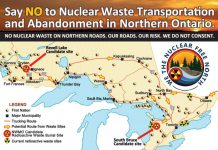OTTAWA – Leaders Ledger – Canada’s nuclear industry is getting close to setting a final storage site for some 50,000 tonnes of accumulated nuclear waste. This is a decision that will have a major impact on Northwestern Ontario. Most people may not know that regardless of the location that’s chosen, people in Northwestern Ontario – and especially Thunder Bay – are likely to see nuclear waste-laden trucks or trains rumbling through town. Many have already started to raise concerns with me.
More than two million bundles of used nuclear fuel rods, each about the size of a fire log, are waiting in temporary storage in seven locations across Canada. More are being produced every year. To get these to a final repository, officials say that there will be at least 53 truck shipments a month over the next 30 years or more (though transport by train or ship could also be used). Storage will have to be one of the longest-term projects in human history: waste will remain dangerously radioactive for hundreds of thousands of years.
The Nuclear Waste Management Organization (NWMO) is charged with finding a community willing to take a nuclear waste repository. They have settled on 21 potential communities. Three towns are in Saskatchewan and six in Southern Ontario, but most are in Northern Ontario: Ear Falls, Ignace, Nipigon, Schreiber, Manitouwadge, Hornpayne, White River, Wawa, Blind River, Elliot Lake, North Shore, and Spanish. The NWMO has been consulting these communities, many of whom have hit hard times. Some residents see nuclear waste as something that may bring much-needed employment to town.
It is understandable that people become concerned when they hear that nuclear waste may be shipped through their community. People in Thunder Bay and along the North Shore of Lake Superior have discovered that they will probably be seeing waste by truck, train, or ship. Much of Canada’s nuclear waste is being temporarily stored at reactor sites in Southern Ontario, but some is also located at the Whiteshell Used Nuclear Fuel Storage Facility in Manitoba, near the Ontario border. If any site in Northern Ontario is chosen, waste would either be shipped north from Southern Ontario by trucks on the highway, by train through towns, or by ship on the Great Lakes. But waste from Whiteshell could also be shipped east through our region.
This raises legitimate concerns. While there have been consultations with the 21 communities being considered for a nuclear waste site, there hasn’t been any such consultation for communities along likely nuclear waste transport routes. Shouldn’t people in the transport corridors have a say too? After all, they are the ones that will see thousands of truckloads of radioactive material going through their streets, and will have to live with the consequences of any accident or nuclear spill.
Therefore this fall, I am embarking on a tour of a number of communities along the nuclear waste route. I’ll be holding public meetings from Southern to Northern Ontario to hear from residents. A number have written to me raising issues about both the opportunities and risks associated with nuclear waste. It’s time they had an opportunity to come together as a community and discuss the subject …before decisions on shipping nuclear waste through their towns are made elsewhere, without their say.
We need to be reasonable in weighing the pros and cons of nuclear waste. Shutting out people that will be impacted won’t help us come to a satisfactory solution. With the scale of this particular problem and long-term impacts faced, this is one decision that has to be done right. I hope you will consider joining me at an M.P. fact-finding meeting near you.
Bruce Hyer, MP





